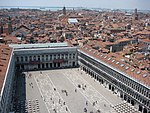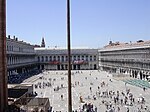Piazza San Marco

Piazza San Marco (Italian pronunciation: [ˈpjattsa sam ˈmarko]; Venetian: Piasa San Marco), often known in English as St Mark's Square, is the principal public square of Venice, Italy, where it is generally known just as la Piazza ("the Square"). All other urban spaces in the city (except the Piazzetta and the Piazzale Roma) are called campi ("fields"). The Piazzetta ("little Piazza/Square") is an extension of the Piazza towards San Marco basin in its southeast corner (see plan). The two spaces together form the social, religious and political centre of Venice and are commonly considered together. This article relates to both of them. A remark usually attributed (though without proof) to Napoleon calls the Piazza San Marco "the drawing room of Europe".
Excerpt from the Wikipedia article Piazza San Marco (License: CC BY-SA 3.0, Authors, Images).Piazza San Marco
St. Mark's Square, Venice Venezia-Murano-Burano
Geographical coordinates (GPS) Address Phone number Website Nearby Places Show on map
Geographical coordinates (GPS)
| Latitude | Longitude |
|---|---|
| N 45.433888888889 ° | E 12.338055555556 ° |
Address
Caffè Florian
St. Mark's Square 57
30124 Venice, Venezia-Murano-Burano
Veneto, Italy
Open on Google Maps









